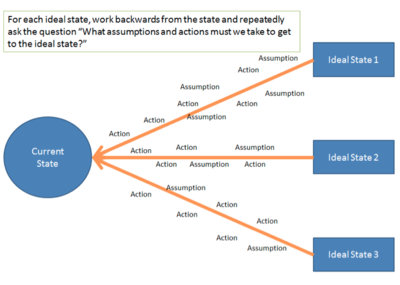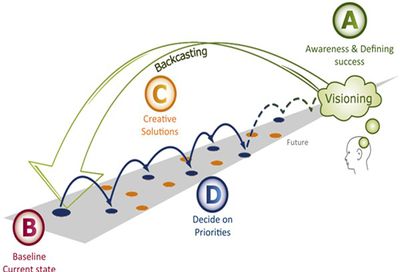Backcasting
The concept of “backcasting” is central to a strategic approach to planning for sustainable development and innovation. A successful outcome is imagined in the future, then the question is asked: “what do we need to do today to reach that vision of success?” We do this all the time when we plan a trip to buy groceries or find a new home. Backcasting is often more effective than forecasting, which tends to produce a more limited range of options, hence stifling creativity. More importantly, forecasting relies on what is known today–but that knowledge is always imperfect and things change over time.[1]
The term "Backcasting" was coined by Robinson (Robinson,1982) as a futures method to develop normative scenarios and explore their feasibility and implications. It became important in the sustainability arena for obvious reasons and is often used as a tool to connect desirable long term future scenarios (50 years) to the present situation by means of a participatory process. After creating a vision of a desirable future, alternative solutions are set out, with the participation of important stakeholders. Those alternative solutions are explored, and bottlenecks identified. With the involvement of the stakeholders, an option is chosen and an action plan set up. The stakeholders then define their roles and commit to them. Backcasting is used in complex situations with many stakeholders where although there is a desired future vision, it is unclear how to reach it. It leads to research plans for implementation of the actions needed and participation is an essential feature. It can be characterized as a social learning process and the long term perspective makes it possible to let go of the present way of meeting certain specific social needs.[2]

source: DUX
Steps in Backcasting[3]
The steps in which backcasting is done are as follows:
- Define and establish the targets or better to be called vision to be pursued
- Gather information of present conditions and circumstances
- Analyze the information gathered to ascertain what changes and amendments are required to the present conditions so that ultimately it comes inline with the vision established.
- Establish a policy and strategy to implement the changes required
Backcasting vs. Forecasting[4]
The activity of backcasting — the term backcasting was coined by John Robinson in 1982 — involves establishing the description of a very definite and very specific future situation. It then involves an imaginary moving backwards in time, step-by-step, in as many stages as are considered necessary, from the future to the present to reveal the mechanism through which that particular specified future could be attained from the present.
Backcasting is not concerned with predicting the future: The major distinguishing characteristic of backcasting analyses is the concern, not with likely energy futures, but with how desirable futures can be attained. It is thus explicitly normative, involving "working backwards" from a particular future end-point to the present to determine what policy measures would be required to reach that future. According to Jansen (1994, p. 503):
Within the framework of technological development, “forecasting” concerns the extrapolation of developments towards the future and the exploration of achievements that can be realized through technology in the long term. Conversely, the reasoning behind “backcasting” is: on the basis of an interconnecting picture of demands technology must meet in the future — “sustainability criteria” — to direct and determine the process that technology development must take and possibly also the pace at which this development process must take effect. Backcasting [is] both an important aid in determining the direction technology development must take and in specifying the targets to be set for this purpose. As such, backcasting is an ideal search toward determining the nature and scope of the technological challenge posed by sustainable development, and it can thus serve to direct the search process toward new — sustainable — technology.
The ABCD Approach[5]
The Natural Step (n.d.) recommends using the ABCD approach to addressing sustainability through the backcasting process. See figure below.
- A = Awareness and Visioning: This first step aligns the organization around a common understanding of sustainability and identifies a 'whole-systems' context for that organisation; building a common language around sustainability as well as creating a vision of what that organisation would look like in a sustainable future.The Natural Step principles of sustainability, basic science and whole-systems approach are presented to develop strategies for living in balance with nature and our global community. Participants review details of the state of the earth's systems, including the ecological, social and economic trends that are undermining our ability to create and manage healthy and prosperous ecosystems, businesses and communities. During the visioning process, people are encouraged to set ambitious goals which may require radical changes in how the organization operates. Some goals may take many years to achieve.This is where businesses often begin to identify the service they provide independent of any one product (for example, providing energy services versus oil). Incorporating this awareness into the visioning process unleashes innovation and releases the company from preconceived limitations.
- B = Baseline Mapping: This step uses the four sustainability principles to conduct a sustainability ‘gap analysis’ of the major flows and impacts of the organisation to see how its activities are running counter to sustainability principles. The analysis includes an evaluation of products and services, energy, capital and human resources from 'cradle to cradle'. The assessment also looks at the social context and organisational culture in order to understand how to positively introduce change. This allows the organisation to identify critical sustainability issues, their business implications, any assets they may have and opportunities for change.
- C = Creative Solutions: In this step, people are asked to brainstorm potential solutions to the issues highlighted in the baseline analysis without any constraints. Armed with their vision of success and potential actions, organisations look backwards from the vision to develop strategies toward sustainability. This is called backcasting and it prevents people from developing strategies that just solve the problems of today. Instead, they begin with the end in mind, moving towards a shared vision of sustainability, with each action providing a platform for further improvement.
- D = Decide on Priorities: After identifying the opportunities and potential solutions in the ‘C’ step, the group prioritizes the measures that move the organisation toward sustainability fastest, while optimizing flexibility as well as maximizing social, ecological and economic returns. This step supports effective, step-by-step implementation and action planning. At this stage, organisations can pick the 'low-hanging fruit' - actions that are fairly easy to implement and offer a rapid return on investment in order to build internal support and excitement for the planning process. Backcasting is used to continually assess decisions and actions to see whether they are moving the organisation toward the desired outcome identified in ‘A' step (awareness and visioning). Sustainability principles provide new design parameters that drive product and process innovation throughout the system. This step also incorporates organisational learning and change methods, essential elements to move people into new ways of thinking and working together. The sustainability principles help people stay on course as they process the myriad of information and decisions involved in long-term planning. What’s considered realistic today never determines the direction of change, only its pace. This approach is based on systems thinking, setting ambitious goals, and developing realistic strategies to achieve them.
Organisations are not expected to achieve long-term goals immediately. They’re encouraged to move systematically by making investments that will provide benefits in the short-term, while also retaining a long-term perspective. They use the Framework for Strategic Sustainable Development to map-out a series of steps that will eventually lead to sustainability.

source: Natural Step
Backcasting Scenarios[6]
With backcasting, a successful outcome is imagined and the question is asked: “what do we need to do today to reach that vision of the future?” Backcasting from scenarios is a bit of a jigsaw puzzle through which a shared picture of the future is created, and pieces are put together to get there. Here are examples of backcasting scenarios along with a series of lead-in questions to help stimulate a discussion.
Scenario: Newspaper headline reads: “World’s first 3D printed housing subdivision breaks ground on Monday.”
Using 3D printers to print small objects is easy, but printing something as big as a house will force people to rethink the entire housing industry. Currently there is a race afoot to see who can 3D print the first house. After the first house, we will see the first bridge, the first commercial building, and perhaps even an effort to print the world’s tallest building.
NOTE: The term being used for 3D printing a building is “contour crafting.”
Questions: How long before an entire house can be “printed” within a single day? Will it also be possible to print the windows, cabinets, sinks, toilets, and other fixtures? When will we be able to grind up an existing house, reuse the material, and reprint it in the same location?
Scenario: Newspaper headline reads: “First highway in the U.S. to be designated as driverless-cars only”
Driverless technology will be implemented in the auto industry in baby steps, first with driverless features and later with totally hands-off navigation systems. Over time the number of driverless vehicles will grow, primarily driven by the aging baby boom generation not wanting to lose their freedom. As the number of driverless vehicles increases, the difficulties of managing half-driver, half-driverless traffic systems will eventually give way to driverless-only highways where cars can drive closer together at much faster speeds.
Questions: How long before we see our first driverless-only highway? What effect will driverless cars have on driver jobs – bus drivers, limo drivers, taxi drivers, etc.? How will this affect car ownership, traffic accidents, traffic courts, and parking lots? What effect will driverless cars have on the auto insurance industry? Who are the winners and losers in this scenario?
References
- ↑ What is Backcasting? The Natural Step
- ↑ Understanding Backcasting For-Learn, JRC European Commision
- ↑ Steps in Backcasting Hasaan Fazal
- ↑ Backcasting vs. Forecasting Wikipedia
- ↑ Addressing Sustainability Through the Backcasting Process natutalstep.ca
- ↑ The Future Favors the Bold: Backcasting Scenarios for Understanding the Future futuristspeaker.com
Further Reading
- Backcasting Approach for Sustainable Mobility JRC European Commission
- An Exploration of Backcasting and Related Approaches ICARB
- Essence of Backcasting Karl H Dreborg
